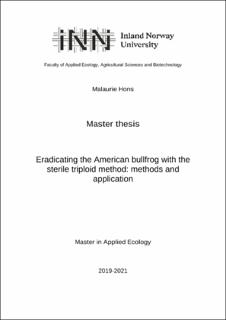| dc.description.abstract | The American bullfrog, an invasive species present all around the world, causes many problems in ecosystems. They are very hard to eradicate because of their complex developmental stages, their abundance, high fertility, and the far distances they can cover. Many eradication methods showed to be non-effective, especially in larger and open populations. This Master thesis study is part of LIFE 3n-bullfrog. LIFE 3n-bullfrog’s main purpose is eradicating or controlling isolated American bullfrog populations using a new method namely the sterile triploid method (STM). By releasing triploid (sterile) bullfrogs in a wild population, females that mate with the triploid males will produce an infertile egg clutch, which eventually results in a decline of the population. In order to evaluate the effectiveness of the STM in the population of interest, a population model has to be build. This would also reveal how many triploids have to be released to get the desired results. The eventual outcome of this Master project is a method for modelling the population of American bullfrogs in Scheps, a small nature reserve in Balen, Flanders. Another outcome of this thesis is the evaluation of two methods for estimating the population size, catch-depletion and eDNA. The catch-per-unit-of-effort (CPUE) was also estimated for catch-depletion, since this method also acts as a control measure and is of major importance in the management plan of the American bullfrog.
Catch-depletion shows to be non-effective for estimating the population size of bullfrogs in this project. The method was not conducted accurately which made the results biased. When catch-depletion would be conducted following some assumptions, the results would most likely be representative. eDNA concentration analysis is not very effective for population size estimation, especially in larger populations, but is effective for detecting (slightly) infected ponds, which is also of major importance in the management of the bullfrog.
The best model to use in this case is a deterministic matrix population model (MPM). Model analysis were done in R, using the package popdemo. Parameters that are essential to include are transition probability and probability of staying in a life stage (calculated from the survival rates), fecundity and sex ratio. To determine how STM would affect the population, the fecundity is lowered by a certain perturbation rate. Using dynamics from another population, the results were not very promising, showing only a slight decrease in the lambda. Including the population dynamics of the target population, the effects of other control measures, the competitiveness of males, the ratio fast/slow track and the initial population size vector, would increase the accuracy and most likely the effects of STM on the population structure and growth. It would also be best to treat the model as a stochastic model and to treat the dynamics as transient instead of asymptotic, which is more likely in wild populations. | en_US |
